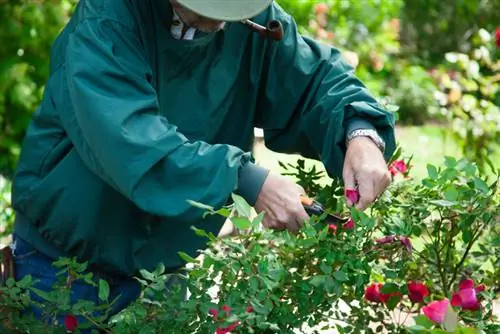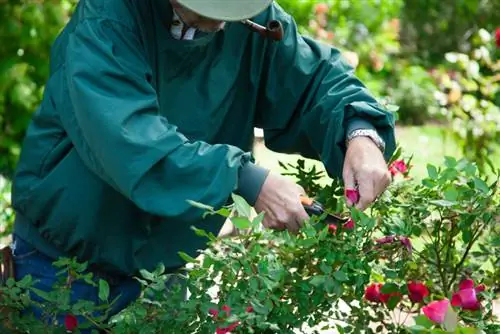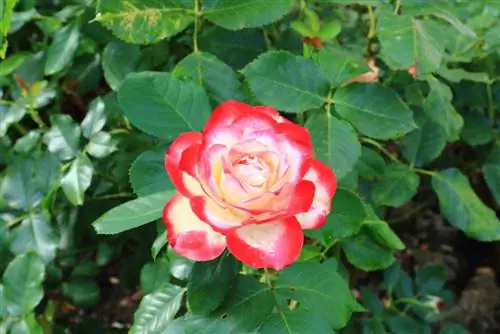- Author admin [email protected].
- Public 2023-12-16 16:46.
- Last modified 2025-01-23 11:20.
Bedding or floribunda roses, as they are also called, are popular garden plants. Although their flowers may not be as impressive as the so-called tea hybrids, floribunda roses bloom continuously over a long period of time, they are also very disease-resistant, can tolerate less than ideal conditions and they don't mind rain. Like all roses, they also need to be pruned regularly, otherwise they will become bald and produce fewer and fewer flowers over time. For the particularly rich flowering of bedding or floribunda roses, there are two cutting dates per year, the most important of which is in early spring. You can find out how to cut back floribunda roses in the following article.

How do you cut floribunda roses correctly?
Prune floribunda roses in spring when the forsythia blooms by shortening shoots by about half, removing damaged and weak shoots and cutting off old leading shoots near the ground. Cleaning out in summer and removing long shoots in autumn also promotes flower formation.
The most important cut takes place in spring
You should cut back floribunda roses at the beginning of spring when they begin to grow. Experienced rose gardeners have identified the beginning of forsythia flowering as the ideal time for this. Shorten the shoots by about half and remove damaged, weak or diseased shoots. In addition, some old leading shoots should be removed directly near the ground so that new basal shoots can form. The previous year's wood, on the other hand, should only be pruned moderately. This selective pruning ensures uniform flowering across the entire plant. Bed roses react wonderfully to effective pruning and reward it with an abundance of flowers.
Clean out floribunda roses that bloom more often in summer
As permanent bloomers, floribunda roses often show their abundance of flowers from early summer until the first frost. If possible, choose self-cleaning varieties, i.e. H. Bed roses that shed dead flowers all on their own. Dead flower heads should be removed regularly for two reasons: on the one hand, cleaning out stimulates the formation of new flowers, since the plant does not have to invest any energy in the development of any fruits, on the other hand, the drying flower heads represent an entry point, especially for fungi - especially in warm, humid weather, as this promotes the development of mildew.
Removal of root shoots
Bedding roses are usually cultivated by grafting (€120.00 on Amazon), which allows root shoots to form. However, these sprout from the original rhizome, not from the grafted variety. If the root shoots are not removed, they will eventually take over and the plant will revert to its rootstock variety. Therefore, you should remove each shoot correctly at the point where it sprouts. You will probably need to clear away some soil first before cutting back the sapling where it sprouts from the rootstock. If you simply cut it off at ground level, it will thrive and grow even stronger.
Remove long shoots in autumn
Shortly before the winter break, you should remove the last flowers - and thus prevent a fungal infection - as well as remove very long shoots. These are often damaged by frost or strong wind, which you can avoid by pruning in good time.
Tip
The golden rule also applies to floribunda roses: the weaker the shoot, the more it needs to be cut back. Strong shoots, however, are only shortened slightly.






